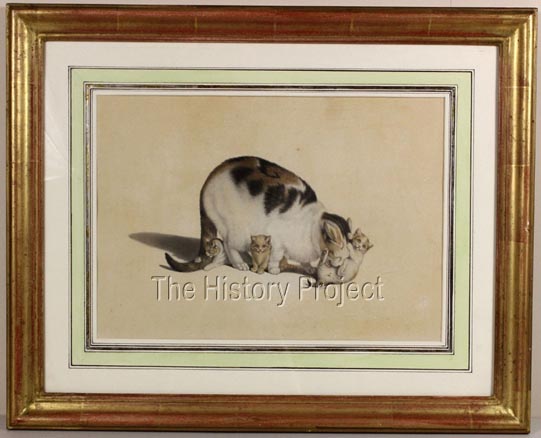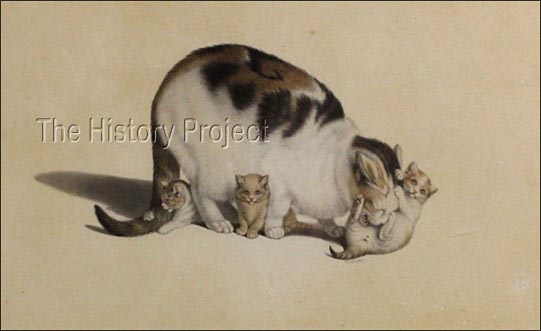








|
|
Gottfried Mind Original Watercolor (1790)
| MUSEUM | FACTFILE |
| Classification |
Artwork |
| Category |
Original Art |
| Artifact |
Original Watercolour on paper by Gottfried Mind |
| Date |
circa 1790's |
| Connection |
The Raphael of Cats - Gottfried Mind (1768 -1814) |
| Collection |
The Harrison Weir Collection |
| Description |
A rare, finely detailed original watercolour on paper, by Swiss born artist and savant, Gottfried Mind; renowned for his sympathetic depiction of Cats, famously referred to as the 'Raphael of Cats'. (Unframed visible margins 34cm x 24 cm) Featuring a Short-haired Mother Cat washing one of her three kittens.
|
| Brief History |
Provenance - once owned by the Von Ernst banking family of Berne, the birthplace of Gottfried Mind. Latterly from the Library of the late Marianne C. Gourary, the painting was acquired from the Galerie Grand-Rue in Geneva, by a well-known Gallery in central London. |
| Acquisition | Purchased for the Harrison Weir Collection, 2018 |
 |
 |
MOTHER CAT & KITTENS, by Gottfried Mind, circa 1790's
Archive of The Harrison Weir Collection
|
Gottfried Mind (September 25, 1768 - November 17,
1814) was a Swiss born autistic savant, who specialised in drawing and
painting Children and Cats, but it is for his sympathetic depiction
of cats that he was especially renown, earning him the epithet the 'Raphael
of Cats'. The following are excerpts from the Wikipedia page on 'Gottfried
Mind,' with specific regard to his art education and his work:
ART EDUCATION:
Mind, in his eighth year, was placed at the academy
for poor children, which Pestalozzi had previously instituted at Neuenhof,
near Bern, Aargau. In the year 1778, in this authentic account of that
institution, published by the Economic Society of Bern, the following
short notice:-"Friedly Mynth of Bossi (Mind of Pizy), of the bailliwick
of Aubonne, resident in Worblaufen, very weak, incapable of hard work,
full of talent for drawing, a strange creature, full of artist-caprices,
along with a certain roguishness: drawing is his whole employment: a
year and a half here: ten years old."
It is not known how long he remained at this academy;
somewhere between the years 1780 and 1785, he came to the painter Sigmund
Hendenberger at Bern. With him, Mind learnt his art of drawing, and
colouring with water-colours.
Mind's education dealt mostly with art; he could
with difficulty be made to write his name, and he had not the slightest
idea of arithmetic. Mind's special talent for representing cats was
discovered and awakened by chance. At the time when Hendenberger was
painting that since-published picture of the peasant cleaving wood before
his cottage, with his wife sitting by, and feeding her child with pap
out of a pot, round which a cat is prowling, Mind cast a broad stare
on the sketch of this last figure, and said in his rugged, laconic way,
"That is no cat!" Hendenberger asked, with a smile, whether Mind thought
he could do it better. Mind offered to try; he went into a corner, and
drew the cat, which Hendenberger liked so much that he made his new
pupil finish it out, and the master copied the scholar's work.
 |
A SKETCH OF GOTTFRIED MIND AT WORK (LATE EIGHTEENTH CENTURY)
Frontispiece: Gottfried Mind - Der Katzen Raffael (1924) by Adolph Koelsch.
Archive of The Harrison Weir Collection
|
Continued from 'Wikipedia'
WORK:
It was not till after Hendenberger's death that Mind fully developed
his peculiar talent for drawing.
His pictures of peasant children, which, for the most part, are
painted on small sheets, depict sports, banterings, quarrellings,
sledge-parties of children, with their half-frozen but still merry
faces, in their puffy yet picturesque costume.
In the course of his narrow, indoors life, he had worked himself
into an almost paternal relation with domestic animals, especially
with cats. While he sat painting, a cat might generally be seen sitting
on his back or on his shoulder; many times he kept, for hours, the
most awkward postures, that he might not disturb it. Frequently there
was a second cat sitting by him on the table, watching how the work
went on; sometimes a kitten or two lay in his lap under the table.
Frogs (in bottle) floated beside his easel; and with all these creatures
he kept up a most playful, loving style of conversation; though, often
enough, any human beings about him, or such even as came to see him,
were growled or grunted at in no social fashion.
His chief diligence and most careful elegance he brought to work
in the painting of his beloved cats. He had both the art to seize
the general nature of this animal and to reflect the specific character
of each. The sycophantic look full of falseness, the dainty movements
of the kittens, several of which are sometimes painted sporting round
their dam-all this, in the most multifarious postures, turns, groups,
sports, and quarrels, is depicted with a true observance to nature.
On Sundays and winter nights, Mind, by way of pastime, used,
out of dried, wild chestnuts, to carve little cats, bears, and other
beasts, and this with so much art that these little dainty toys were
shortly in no less request than his drawings. It is a pity that insects,
such as frequently exist in the interior of chestnuts, have already
destroyed so many of these carvings.
At the Barengraben (bear-yard) in Bern, where a few live bears
are always to be seen, Mind passed many a happy hour. The moment he
made his appearance, the bears hastened towards him with friendly
grumbling, stationed themselves on their hind feet, and received,
impartially, each a piece of bread or an apple out of his pocket.
For this reason, bears, next to cats, were a favourite subject of
his art; and he reckoned himself, not unjustly, better able to delineate
these animals than even celebrated painters have been. Moreover, next
to his intercourse with living cats and bears, Mind's greatest joy
was in looking at objects of art, especially copper-plates, in which,
too, animal figures gave him most satisfaction.
Herr Sigmund Wagner, of Bern, who possessed a choice collection
of copper-plates, frequently invited Mind, on winter Sunday evenings
to his house, and would then show him his volumes. While Herr Wagner
might be writing, reading, or drawing, Mind, grumbled to himself half-aloud,
made his remarks on each sheet, and frequently gave a true, stubborn,
rugged judgment even on the most celebrated masters, especially on
pictures of animals. Among these, nothing pleased him but the lions
of Rubens, of Rembrandt, and Potter, and the stags of Kidinger; the
other animals of the latter he declared to be falsely drawn. Even
the most applauded cats of Cornelis Visscher and Wenzel Hollar could
not obtain his approbation.[5]
Mind seldom drew from Nature; at most he did it with a few strokes.
His conception was so strong, that whatever he had once strictly observed,
stamped itself so firmly in his memory that, on his return home, and
often a considerable time afterwards, he could represent it with entire
fidelity. On such occasions he would look now and then, as it were,
into himself; and when at these moments, he lifted his head, his eyes
had something dreamy in them.
DEATH
In late 1813, Mind began suffering from "an increasing disorder
in the breast" which left him unable to exert himself. On 17 November
1814, he died of this illness, at the age of 46.
 |
ANOTHER ETCHING OF GOTTFRIED MIND AT WORK
From the title page of an early 19th century biography of Mind.
Archive of The Harrison Weir Collection
|
Many of Gottfried Mind's images are cats, both originals and antiquarian prints
have been collectors pieces for over two centuries. Within a decade
of his death, stone block coloured reproductions of his works were popular
throughout Europe and many are valuable collector items today. One or
two of these small but highly detailed prints are held in The Harrison
Weir Collection, along with at least two period biographies containing
multiple images of cats.
The featured watercolour which is the subject of this article, has
also been reproduced in lithographic form and may be readily found in
an on-line search.
When we were looking for an original piece of his work for the Collection,
we sought to find a 'cat' study which would widely appeal to lovers
of cats. This piece was our preferred option of the very few that were
available at the time of our search.
After this piece had been secured and had arrived, we examined it in
detail, finding that the artist's brushwork was so fine, that we needed
extra lighting and a magnifying glass to study the detail, which is
simply remarkable; very nearly photographic in its accuracy and refinement.
Mind's passion for his subject is apparent, and his incredible ability
and attention to detail could easily be interpreted as an act of 'adoration'.
|













